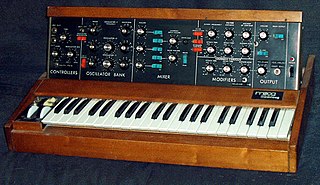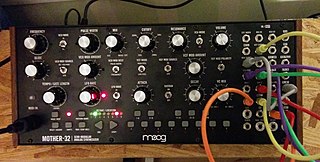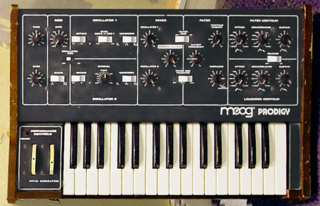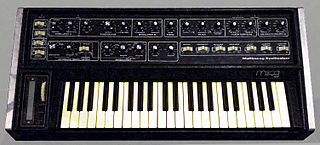 W
WThe ARP 2600 is a semi-modular analog subtractive audio synthesizer, designed by Dennis Colin for Alan R Pearlman, and manufactured by his company, ARP Instruments, Inc. as the follow-on version of the ARP 2500.
 W
WThe ARP Pro Soloist was one of the first commercially successful preset synthesizers. Introduced by ARP Instruments, Inc. in 1972, it replaced the similar ARP Soloist (1970-1971) in the company's lineup of portable performance instruments.
 W
WThe Arturia MiniBrute is a monophonic, pure analog synthesizer designed and manufactured by Arturia, a French synthesizer software and hardware company. Although the MiniBrute was the first piece of hardware created by Arturia—which had previously exclusively marketed software synthesizers—it generated strong sales.
 W
WThe VL-1 was the first instrument of Casio's VL-Tone product line, and is sometimes referred to as the VL-Tone. It combined a calculator, a monophonic synthesizer, and sequencer. Released in June 1979, it was the first commercial digital synthesizer, selling for $69.95.
 W
WThe Doepfer A-100 is an analog modular synthesizer system introduced by German audio manufacturer Doepfer in 1995. Although it only had 10 modules at time of release, it currently has more than 120 modules plus several different enclosures and accessories.
 W
WThe VCS 3 is a portable analog synthesiser with a flexible semi-modular voice architecture, introduced by Electronic Music Studios (London) Limited (EMS) in 1969.
 W
WKorg MS-10 is an analogue synthesizer created by Korg in 1978. Unlike its bigger brother, the MS-20, the MS-10 only has one VCO, one VCF and one envelope generator. It is monophonic and has 32 keys.
 W
WThe Korg MS-20 is a patchable semi-modular monophonic analog synthesizer which Korg released in 1978 and which was in production until 1983. It was part of Korg's MS series of instruments, which also included the single oscillator MS-10, the keyboardless MS-50 module, the SQ-10 sequencer, and the VC-10 Vocoder. Additional devices included the MS-01 Foot Controller, MS-02 Interface, MS-03 Signal Processor, and MS-04 Modulation Pedal.
 W
WThe Moog model 2090 Micromoog is a monophonic analog synthesizer produced by Moog Music from 1975–79.
 W
WThe Minimoog is an analog synthesizer first manufactured by Moog Music between 1970 and 1981. In the 1960s, synthesizers—in the form of large, expensive, and complex modular synthesizers—were inaccessible to most musicians. The Minimoog was designed as an affordable, portable, simplified instrument which combined the most useful components of the Moog synthesizer in single device. It was the first synthesizer sold in retail stores. It was first popular with progressive rock and jazz musicians and found wide use in disco, pop, rock and electronic music.
 W
WThe Minimoog Voyager or Voyager is a monophonic analog synthesizer, designed by Robert Moog and released in 2002 by Moog Music. The Voyager was modeled after the classic Minimoog synthesizer that was popular in the 1970s, and is meant to be a successor to that instrument.
 W
WThe Realistic Concertmate MG-1 is an analog synthesizer manufactured by Moog Music in 1981 and sold by Radio Shack from 1982 to 1983 under their "Realistic" brand name. It was produced without some standard Moog features, such as pitch and modulation wheels, as a cost-cutting measure aimed at achieving a lower price for the consumer market. The synthesizer also featured a pair of pass-through RCA jacks, which allowed users to mix radio or records into the final live synthesized sound output.
 W
WThe Grandmother is an analog semi modular, 32 key synthesizer released by Moog Music Inc. incorporating circuits based on the Moog modular synthesizer Model 15, and the Minimoog.
 W
WThe Little Phatty is a monophonic analog synthesizer manufactured by Moog Music from 2006 to 2013, preceded by the Voyager and succeeded by Voyager Old School. Its design was conceived, in part, by Robert Moog himself, and is the last instrument to have that distinction, although the primary engineer was Cyril Lance. It is also the first Moog product to be produced following his death. Jordan Rudess of the band Dream Theater also assisted with the design of the product.
 W
WThe Mother-32 is a semi-modular analog synthesizer. Introduced in 2015, it was the first tabletop unit produced by Moog Music. It has a single voltage controlled audio oscillator, a voltage controlled low frequency oscillator, a voltage controlled filter switchable between high and low pass, an AR envelope generator with switchable sustain, a voltage controlled amplifier, and a white noise generator. It also features a 32–step monophonic sequencer, a 13-note keypad, and a 32-point patch bay including assignable outputs. The Mother-32 is manufactured in Asheville, North Carolina.
 W
WThe Moog Prodigy was a monophonic analogue synthesizer produced by Moog Music from 1979 to 1984. Of the 11,000 produced, versions released after 1981 included a control voltage/gate input on the back that allowed the VCF to be triggered and controlled by an external source. These later versions began at serial number 4610. The official model number of the instrument is 336. 336A would indicate a domestic (US) model, while a 336BX would indicate an export unit.
 W
WThe Moog Rogue is a monophonic analog synthesizer produced by the original Moog Music in the early 1980s, but, was not designed by Bob Moog. Very basic in its design and use, the Rogue featured a 32-note keyboard and two VCOs. VCO number 2 is tunable between a half-step below to an octave above VCO number 1. This allows the Rogue to play atonal sounds like the Moog Prodigy. The Rogue did not have features to allow the user full flexibility to program the patch settings, however the VCF and the VCA were simple in operation. The design of the hard-wired patch system was well thought out and a wide variety of sounds and modulation effects are possible. The Rogue also includes a Sample-and-Hold feature that the Prodigy does not. The synthesizer is most commonly used for its powerful bass. The Rogue is similar in some respects to the famous ARP Odyssey, though smaller and slightly less versatile.
 W
WThe Moog Source is a monophonic Z80 microprocessor-controlled analog synthesizer manufactured by Moog Music from 1981 to 1985. The Source was Moog's first synthesizer to offer patch memory storage. The design was also the first Moog synthesizer to feature a flat-panel membrane keyboard to replace the standard buttons, knobs and sliders, along with multihued panel graphics that were very different from anything Moog offered at the time. Sound wise it is considered to sound more like the original Moog Minimoog than any other synthesizer made by Moog and was introduced as its replacement.
 W
WThe Moog Sub 37 is a monophonic analog synthesizer manufactured by Moog Music from 2014. The synthesizer has an analog signal path and digital modulators. In May 2017, Moog announced its successor, the Moog Subsequent 37 CV, which featured an additional four assignable CV outputs, and two gate output in a limited edition of 2000 units.
 W
WThe Moog synthesizer is a modular synthesizer developed by the American engineer Robert Moog. Moog debuted it in 1964, and Moog's company R. A. Moog Co. produced numerous models from 1965 to 1980. It was the first commercial synthesizer, and is credited with creating the analog synthesizer as it is known today.
 W
WThe Moog Taurus is a foot-operated analog synthesizer designed and manufactured by Moog Music, originally conceived as a part of the Constellation series of synthesizers. The initial Taurus I was manufactured from 1975 to 1981; a less successful redesign, Taurus II, followed from 1981 to 1983. Instead of a conventional keyboard, the Taurus uses an organ-style pedal board similar to the pedal keyboard of a spinet organ. This control method was chosen because the Taurus was intended to be played by foot while the player's hands played one or more keyboards, although it was often used by guitarists. While the original Taurus featured its own synthesis engine, the Taurus II was essentially the same as the Moog Rogue. In 2010, Moog issued the Moog Taurus III which closely emulates the analog circuitry of the Taurus I, in addition to adding some modern features.
 W
WThe Mother-32 is an analog semi-modular desktop synthesizer released by Moog Music Inc. in 2015.
 W
WThe Multimoog is a monophonic analog synthesizer manufactured by Moog Music from 1978 to 1981. Derived from the earlier Micromoog, the Multimoog was intended to be a less expensive alternative to the Minimoog. It nevertheless had some advanced features which the Minimoog did not—most notably, it was one of the earliest synthesizers to feature aftertouch capability.
 W
WThe Oberheim OB-1 was a monophonic, programmable, analog synthesizer introduced by Oberheim Electronics in 1978. It originally sold for $1,895 and was the first analog synthesizer capable of storing patches. The design was a replacement for the previous generation of Oberheim SEM based instruments and intended to be used for live performance.
 W
WThe OSCar was a synthesizer manufactured by the Oxford Synthesiser Company from 1983 to 1985. It was ahead of its time in several ways and its later versions were among the few mono-synths of its time to have MIDI. Around 2000 were made.
 W
WThe SH-3A is a monophonic analog synthesizer that was manufactured by Roland from 1975 to 1981. It is unique in that it is capable of both subtractive synthesis and additive synthesis. Two LFOs and a unique sample-and-hold section provided capabilities not found in competing self-contained synthesizers of the time. The SH-3A was Roland's first non-preset based synth. It was unique for its time in that it offered mixable waveforms at different footages. The predecessor, the Roland SH-1000 could also do this but didn't offer as much control as on the SH-3A. The rhythmic pulsing in the Blondie song "Heart of Glass" is an example of its sound.
 W
WThe Roland SH-101 is an analog synthesizer manufactured by the Roland Corporation between 1982 and 1986. Though it was a commercial failure, it became a staple of electronic music in the 1990s, particularly house music.
 W
WThe Roland SH-1000, introduced in 1973, was the first compact synthesizer produced in Japan, and the first synthesizer produced by Roland. It resembles a home organ more than a commercial synth, with coloured tabs labelled with descriptions of its presets and of the "footage" of the divide-down oscillator system used in its manually editable synthesizer section. It produced electronic sounds that many professional musicians sought after whilst being easier to obtain and transport than its western equivalents.
 W
WThe Roland System 100 was an analog semi-modular synthesizer manufactured by Japan's Roland Corporation, released in 1975 and manufactured until 1979. It consisted of the following products:
 W
WThe Roland System 700 was a professional monophonic modular synthesizer for electronic music manufactured by the Roland Corporation and released in 1976 and was followed by the Roland System-100M in 1978.
 W
WThe Roland TB-303 Bass Line is a synthesizer released by the Roland Corporation in 1982. Designed to simulate bass guitars, it was a commercial failure and was discontinued in 1984. However, cheap second-hand units were adopted by electronic musicians, and its "squelching" or "chirping" sound became a foundation of electronic dance music genres such as house and techno. It has inspired numerous clones.
 W
WThe Steiner-Parker Synthacon is a monophonic analog synthesizer that was built between 1975 and 1979 by Steiner-Parker, a Salt Lake City-based synthesizer manufacturer. It was introduced as a competitor to other analog synthesizers, like the Minimoog and ARP Odyssey.
 W
WThe theremin is an electronic musical instrument controlled without physical contact by the thereminist (performer). It is named after its inventor, Leon Theremin, who patented the device in 1928.
 W
WThe Yamaha CS-15 is a Monophonic analog synthesizer produced by Yamaha from 1979 to 1982.